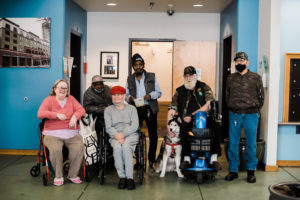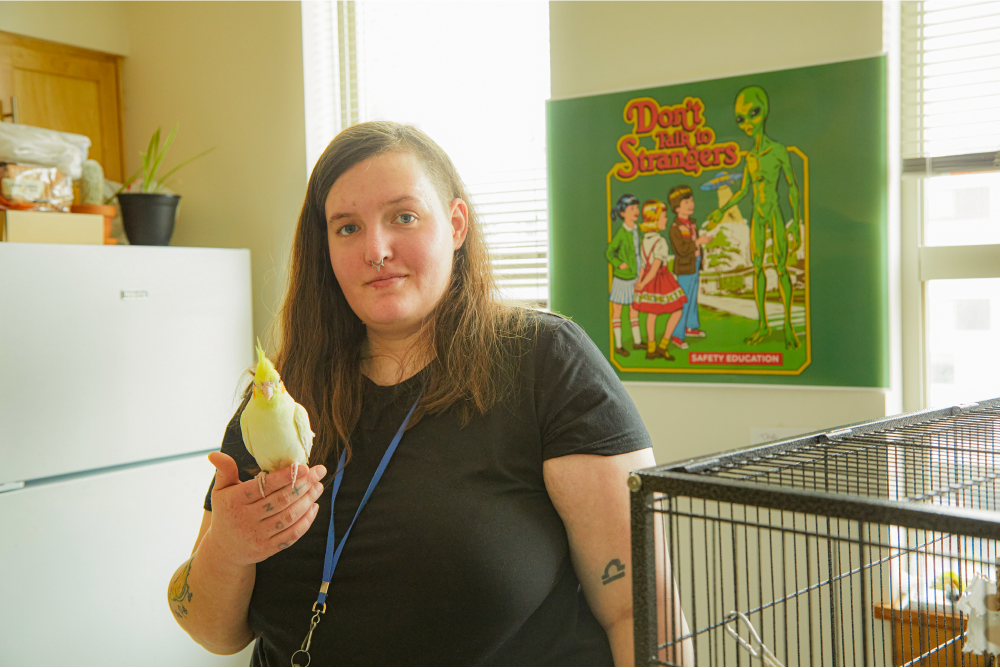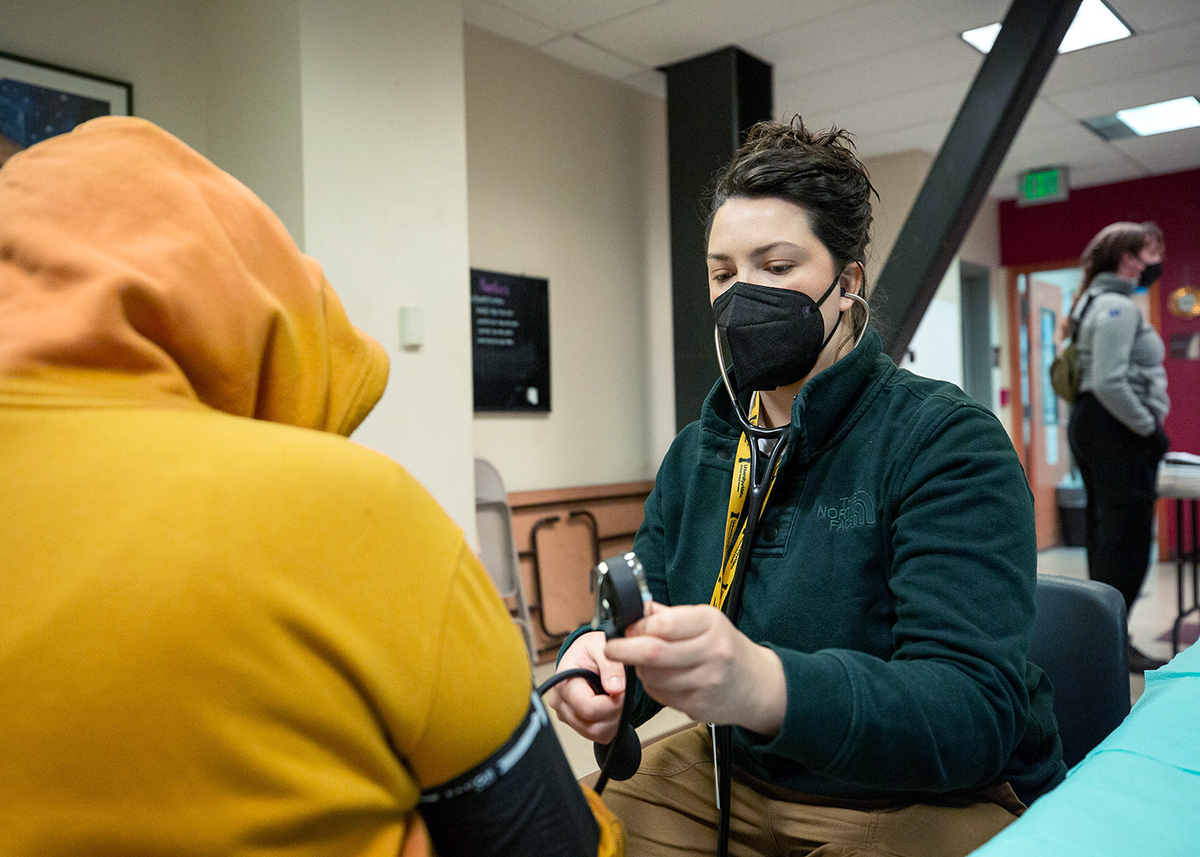
Residents of the Langdon and Anne Simons Senior Apartments.
This entry was originally published in April 2024 and was updated in October 2024.
At Plymouth Housing, we are focused on helping residents achieve stability and improve their quality of life. To do this, we use methods that are backed by science and considered best practices in our field. One of those approaches is called harm reduction.
Harm reduction is a set of strategies and ideas aimed at reducing negative consequences associated with drug use. It accepts that drug use is part of our world and works to minimize its harmful effects rather than simply ignore or condemn them, acknowledging that some ways of using drugs are clearly safer than others. Importantly, harm reduction sees the quality of an individual’s life and well-being—not necessarily the cessation of drug use—as the criteria for successful interventions. You can read more about these harm reduction principles from the National Harm Reduction Coalition.
Plymouth’s focus on harm reduction allows us to help residents work toward stability and recovery in the way that’s right for them. For example, one Plymouth resident, Darryl (who shared his story with KUOW last year), manages his substance use through a Plymouth program called contingency management. Another resident, August, chose an abstinence-intended Plymouth building to address her previous drug use in an environment where substance use is not permitted.
More than half of the people who live at Plymouth Housing are navigating substance use disorder—classified as a disability under the Americans with Disabilities Act (ADA). And this comes as no surprise. Looking at homelessness nationally, we see that some (not all) people who have experienced homelessness use substances. This can be for adaptive reasons: to stay awake in a situation where one’s personal space and belongings are completely unprotected. It can also be to cope with trauma—the effects of which can alter one’s DNA and impair brain function, according to research by Dr. Nadine Burke Harris, former Surgeon General of California.

Plymouth resident August with her cockatiel, Pika.
For people navigating trauma (not to mention the stigma of having experienced homelessness), harm reduction offers an approach that’s both proven, and non-judgmental.
At Plymouth, this means we work with residents in achieving their goals (including abstinence) and give them the tools and information they need to stay safe along the way. Sometimes this looks like one-on-one counseling or trying a variety of different approaches to find what will stick. Other times, it might look like making sterile supplies available for someone who plans to use drugs to help them avoid further harm while they work toward goals that are within reach.
Healing from the trauma of homelessness is a journey, not a destination. Life skills aren’t learned overnight, and managing challenges like mental health and substance use takes time. Our staff dedicate time to building rapport with residents and help them to build skills as they work at their individual pace and ability.
Experts Agree: Harm Reduction Is Effective
Every presidential administration in the last 10 years has acknowledged the success of harm reduction, as it has been scientifically proven to reduce harms associated with drug use and increases the likelihood of an individual to initiate substance use disorder treatment, versus forcing treatment upon someone who is not ready.
Harm reduction focuses on strategies to support an individual’s safety and health—but at its core it is about providing care with dignity, autonomy, and compassion. As the National Institute on Drug Abuse describes it, “’Harm reduction’ is defined as interventions aimed to help people avoid negative effects of drug use, but many understand harm reduction as a way to meet people where they are with kindness and respect.”

Photo by Prenz Sa-Ngoun.
There is a huge amount of research behind harm reduction as an effective approach to improving outcomes, including here in Seattle. Dr. Susan E. Collins, PhD (a professor, licensed clinical psychologist, and co-director of the Harm Reduction Research and Treatment Center at the University of Washington, or HaRRT) is a leading researcher focused on substance use, with more than 80 peer-reviewed articles on the topic. In her words, “Harm reduction interventions, when thoughtfully executed with community input, does not enable more use; instead, it decreases substance-related harm and even use.” Plymouth, like the Biden-Harris Administration, the King County Coalition on Homelessness, DESC, and many, many others, is committed to providing the support people want—not forcing them into ineffective treatments.
Abstinence is an effective approach for some people with substance use disorder, and we applaud the organizations that provide treatment with abstinence as the goal—including one of Plymouth’s buildings, the Pat Williams Apartments, where residents are required in their lease to avoid substance use.
But making housing contingent on abstinence across the board fails to recognize the reality that this expectation is not realistic, or even possible, for everyone who needs housing support. At Plymouth Housing, we are committed to working with each individual to support their path to health and stability, and to set people up for success.
What does harm reduction look like at Plymouth?
Knowledge: First and foremost, we practice harm reduction by giving people who are already using substances the information and tools they need to minimize their risk and consider seeking treatment. This includes making sure that people know how to interrupt an overdose if it’s happening, and how to use naloxone, or Narcan.
We also make sure that residents are familiar with the Good Samaritan Law, which offers legal protection to people assisting others in peril. Knowing this law reduces hesitation to help someone who is overdosing or experiencing distress. Plymouth residents are encouraged to look out for each other.
Safe, clean materials: Plymouth makes clean needles and Sharps containers available to encourage safe use and disposal, helping avoid risk of infection and cross-contamination. Depending on the building, we have items like fentanyl test strips and sanitary supplies to reduce additional risks associated with substance use. Plymouth does not give these items out proactively; rather, they are things that residents can ask for.
Positive reinforcement: A critical harm reduction tool we use at Plymouth is our contingency management program, which uses positive reinforcement to encourage change. The program provides a monetary reward, in the form of gift cards, for recovery efforts. If a resident who uses meth, cocaine, or other stimulants achieves negative drug tests at certain times during the program, they are rewarded for changing their behavior and receive support on their path to recovery.
Plymouth resident Michael Crowley told The Seattle Times of the program, “It put me in a position where I’m held accountable to someone else in my life.” You can also read more about contingency management at Plymouth in KUOW.
Peer support: Peer counselors at Plymouth use their lived experience in recovery from mental illness and/or substance use disorder to help residents create and accomplish goals and find services that promote recovery and lead to increased meaning and purpose. For many individuals, receiving support directly from people who have experienced similar struggles is far more powerful and effective than other avenues.
At Plymouth, everything we do is ultimately focused on recovery, encouraging residents to improve their health and wellness, live self-directed lives, and strive to reach their full potential. The harm reduction approach simply means that we do not force people to receive help they are not ready or willing to receive. Instead, we meet people where they are and tailor our care to individual needs. Because everyone’s journey is different, and everyone deserves to be treated with dignity and respect.
For more information about harm reduction, see: